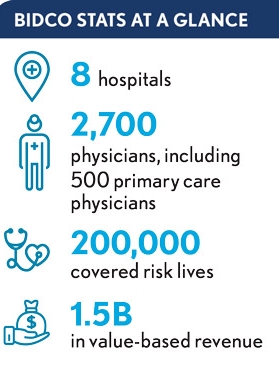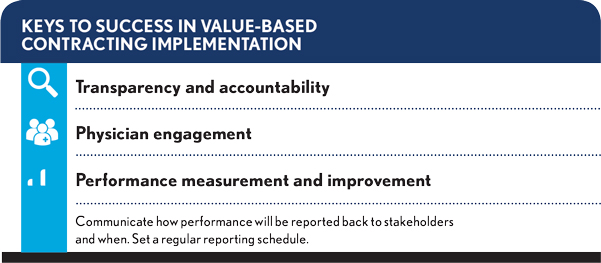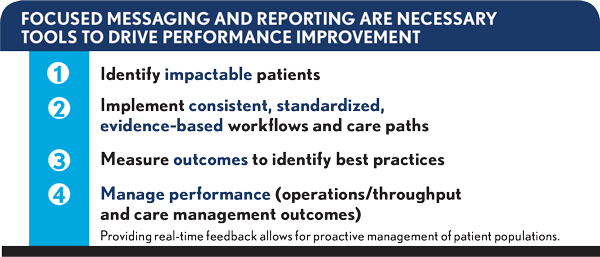How one ACO leveraged universal truths of value-based contracting for success

Jennifer Carney, finance leader of the newly formed Beth Israel Lahey Health Performance Network, describes key elements that drove success under value-based payment contracts at a flourishing ACO in Boston.
The challenges physicians face in adapting to value- based payment are well-documented, and often cited as a cause of burnout.a And that’s why a hallmark of successful accountable care organizations (ACOs) is the ability to simplify the complexities of value-focused care for physicians, according to Jennifer Carney, vice president of finance and analytics for Beth Israel Lahey Health Performance Network (BILHPN) in Boston, formed in March 2019, with Beth Israel Deaconess Care Organization (BIDCO) — whose experience is described here. As an industry-leading ACO, BIDCO has valuable lessons to offer other healthcare organizations seeking the best path forward as they form ACOs to venture into value-based contracting.
BIDCO has broad experience as a pioneer in forging and refining its risk-contracting strategy, having been an early participant both in the Medicare Shared Savings Program and in emerging commercial value-based payment contracts. To share helpful insights based on this experience, Carney recently described for hfm some elements that have been the key in helping BIDCO sustain its high level of performance under value-based care.


The universal truths of value-based care
At HFMA’s Annual Conference in June, Carney gave a presentation focused on “the universal truths of value-based care.” Her inspiration for this theme came from a 2017 survey of family practice physicians on value-based payments and the barriers to implementing value-based contracts. Three barriers cited by physicians under the practice-sustainability heading caught Carney’s attention:
- Lack of resources
- Unpredictability of the revenue stream
- The difficulty of understanding the complexity of the financial risk
“It struck me that these barriers are key and truly reflect universal truths of value-based contracting,” Carney said. The fact that the barriers were identified by physicians also underscores the need to address these universal truths in the context of obtaining physician buy-in and engagement in the organization’s value-focused efforts.
Carney says these are three major hurdles that must be addressed with physicians if an ACO is to be successful.
Resources. Before an organization implements a value-based contract, it must understand that it requires clinical, IT and analytical resources to enable its physicians to perform well under the contract.
Revenue stream. As a real shift from the fee-for-service model, the shared surplus or bonus payments, whether they are for quality or efficiency, are not guaranteed under value-based contracts. “Physicians and other stakeholders need to understand we’re moving away from that guaranteed fee-for-service payment for each service performed [and] toward bonus payments or other quality incentive dollars where there’s quite a bit of lag in those payments getting paid out,” Carney said.
Complexity of the risk model. Understanding the complexity of financial risk involved with value-based contracts is a challenge, and physicians need help in overcoming this barrier. The sheer number of elements involved make it difficult to understand what’s needed to perform effectively under these contracts.
BIDCO’s ability to address these three elements is a key driver of its success as an ACO. And it has required a focus on communication, education and analytics to help physicians and other stakeholders embrace the value-based model with a clear sense of purpose and direction. (See also the sidebar, “3 components of shared risk.”)
It starts with communication
“Communication is key,” Carney said. “The complexities of the risk model make communication and transparency essential to performing well in a value-based contract. It’s hard to ask physicians and hospitals to perform under these new models if they don’t understand what the rules of the game are. To create a focus, you need to cut through all the complexity and make it as simple and directive as possible to drive performance.”
To help minimize the complexity of the value-based enterprise for physicians across its network, BIDCO started by grouping its physicians into pods, with an average of 28 physicians in each pod, and then identifying physician champions to represent each pod at the network level. “This approach helps us bring our stakeholders together at the table and educate them on the components of risk,” Carney said.
“To ensure there’s engagement and buy-in from the physicians, we involve them in all pieces of building out our incentive models and related measurements,” Carney said. “We seek their feedback through their physician champions on how best to measure performance. And then we work internally to create our reporting and the analytics that will drive the focus.”
BIDCO’s goal is to ensure that its physicians understand and agree on what the measurements of performance improvement are and how to succeed with them. The organization works to meet that goal by providing, on a regular schedule, transparent and aligned reporting of reliable information tailored to physicians’ needs to allow them to monitor and track their performance.
BIDCO sees the challenge as boiling down the complexity of these models for its physicians. “Consider that we have more than 10 risk contracts, all with different rules,” Carney said. “Just looking at the quality measures alone, one of our contracts has 32 different quality measures. And those measures can vary from contract to contract.”

Focus on improving quality with tailored analytics
In part, BIDCO reduces complexity for physicians by tailoring analytics and strategies at the local pod level and working with each pod to help them understand how to drive performance. With tailored analytics, quality metrics are likely to differ among pods. For example, a pod that has a large number of pediatric patients might focus on well-child visits, making sure to perform more outreach to raise quality scores in this area. Another hypothetical example might be a pod that has relatively low mammography rates. Here the quality metrics might be focused on improving mammography compliance.
“Sometimes, certain outcome measures carry more weight in the contract,” Carney said. “And when providers perceive that these metrics are driving greater value and improved patient outcomes, they are more likely to view the metrics as an area of opportunity.”
Strategies to educate physicians
Carney emphasizes that educating clinicians on the value-based models starts with convening the right stakeholders at the table on a regular basis.
BIDCO does three things to promote focus and prioritization with this group:
- Meets at least quarterly to review and discuss performance.
- Monitors and measures performance on a regular basis.
- Creates dashboards for each provider pod so physicians can see how they’re performing against these metrics.
These actions not only help demystify the value-based model but also bring needed resources to help physicians understand where to focus their efforts under the model. BIDCO also reviews performance on each risk-based contract and on its financial incentive models quarterly to assess the metrics and make course corrections if needed. Meetings with physicians are both face-to-face and by phone, and sometimes they involve webinars.
“We work constantly with the individual pods,” Carney said. “Then, on a monthly basis, we have a meeting of the Primary Care Physician (PCP) Advisory Committee that gets those physician champions together, whether by a webinar or in person, to promote knowledge exchange through brainstorming, education and questions.”
BIDCO gains input from the physician champions by running ideas through the meeting and soliciting their feedback.
Use actionable data to give physicians direction
BIDCO has made a commitment to developing the resources to provide actionable data to clinicians to engage them in performance improvement.
“We provide physicians with actionable data through focused reporting using a population health tool,” Carney said. “Physicians can access the tool themselves and pull their care gap reports or other reports that identify for them who the actionable patients are.”
The reporting is focused to avoid overwhelming physicians with too much information, and it’s actionable and directive to allow them to focus on the next step.
“Physicians are provided with lists of patients we would like them to reach out to,” Carney said. “Then we monitor the outcomes of those patient interactions against our targets to see if there’s improvement or a need for a course correction.”
And the focus is not limited to the highest-cost patients.
“We also focus on patients who present an opportunity for managing their health going forward,” Carney said. “We have a program we call our Rising-Risk Management Program that focuses on that middle tier of patients who don’t show up as your highest-cost patients. But if they’re not managed, they very well could end up in that high-cost category.”
Carney describes it as moving beyond predictive analytics to prescriptive analytics, driving outcomes for rising-risk patients by prescribing the outcomes to be avoided, including costly hospitalizations, and instead keeping patients in their homes to receive the care they need.
“To see improvement, there could be some areas where reaching out to only a handful of patients is all that’s needed to get you to the next gate, which drives your performance and your incentives score,” she said. “So that’s a good opportunity.”
Carney also notes there might be areas where an ACO has not even hit the minimum gate yet, which can have a big impact on its overall score.
“If you are still short of the minimum gate, you might want to focus on at least getting there,” she advises. “It’s our job to urge physicians to focus on those areas and let them know which patients they should reach out to. Our population health tool also allows physicians to drill down and get care gap reports to help them in their everyday practice.”

Required resources
The need for resources is paramount and ongoing. For BIDCO, key resources are both clinical and IT related. “There’s the clinical care management piece, where we interface with the providers,” she said. “But on the IT and analytical side, you need data-integration folks who can bring the information together to support efforts to achieve targeted outcomes, especially in a system like ours where we’re not on one electronic health record.”
An important resource that is all-too-easily overlooked, Carney said, is having staff devoted to analyzing contract performance across all risk contracts.
“You need the right resources on the analytics side to understand all the components of each value-based contract, what those levers are and where opportunities exist to drive performance,” she said. “You need that capability because you shouldn’t just accept the word and reports of the payer as your single source of truth. We put a lot of time and effort into collaborating with payers and making sure we understand all the pieces of the contract. And having in-house analytics can give us a second set of eyes on those settlements to make sure that everything is covered at the end of the day.”
The key to success
To be successful under value-based care, an organization should have as its primary goal the ability to provide transparency and accurate information that allows physicians to make informed decisions and know what levers to pull to manage and impact revenue and payment. In accomplishing that goal, an ACO can address all three universal truths for all stakeholders — the need for resources, the assurance of payment and comfort with the complexities of the model.
“Again, it comes back to understanding the rules of the game,” Carney said. “You can’t ask physicians to perform if they don’t know what they’re being measured against. Physicians need to have a voice and a stake in the process.”





